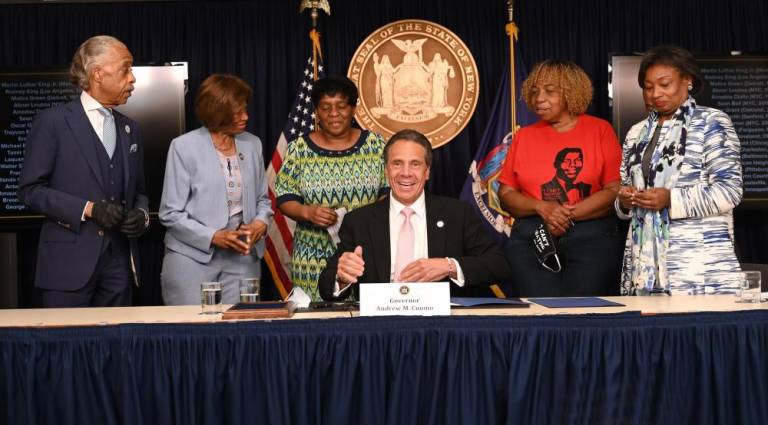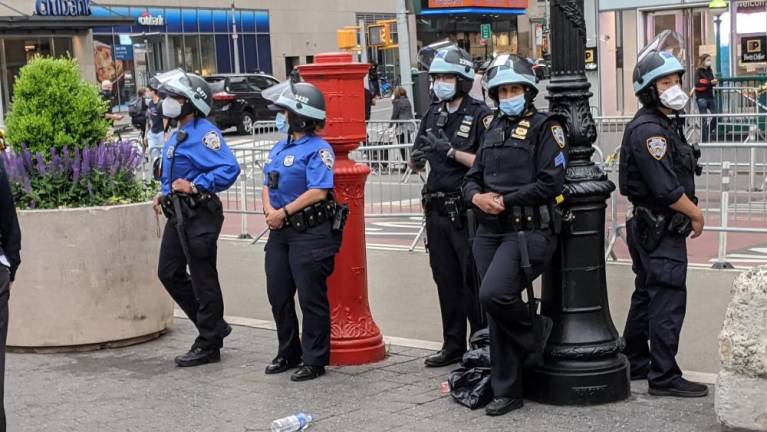Reforming the Police
NYPD disbands plainclothes anti-crime unit, City Council looks at funding cuts, Cuomo signs new measures


Weeks after the death of George Floyd in Minneapolis, protesters are still taking to the streets demanding police reform — with some calling for the total abolition of law enforcement.
A common refrain among protesters has called for government officials to “defund the police.” In implementation, defunding the police would taking funds away from the police budgets and reallocating them to areas such as education, housing, public health and youth services. Some on the City Council seem to be on board with the idea.
City Council Speaker Corey Johnson said the council has identified $1 billion in cuts to the NYPD’s $6 billion budget. He asked Mayor Bill de Blasio to sign on before the city’ budget deadline on July 1.
The mayor gave it little consideration, but said he would be open to discuss further the size of the city’s law enforcement.
“The mayor has said we’re committed to reprioritizing funding and looking for savings, but he does not believe a $1 billion cut is the way to maintain safety,” said de Blasio’s press secretary, Freddi Goldstein.
On Monday, Police Commissioner Dermot Shea unexpectedly announced that the department’s anti-crime unit would be disbanded. Made of about 600 plainclothes officers, the unit’s purpose was to target violent crime, but, as the New York Times reported, it has been involved in many of the city’s police shootings. Shea said the officers would be reassigned to other units immediately.
Criminalizing Chokeholds
Last week, New York State began implementing a slew of reforms, including the repeal of a long-vexed stature that kept police disciplinary records from public scrutiny.
“The truth is this police reform is long overdue and Mr. Floyd’s murder is just the most recent murder,” Gov. Andrew Cuomo said on Friday. “It’s not just about Mr. Floyd’s murder, it’s about being here before many, many times.”
On Friday, Cuomo signed into law four bills put forward by the state legislature, with six other pieces of legislation awaiting his signature. On top of these measures, Cuomo signed an executive order that makes state funding to police contingent upon the departments creating a plan to “reinvent and modernize police strategies” by April 1. These plans would need to include guidelines for the use of force against citizens. The order is expected to be codified following consultation with local communities.
One of the four measures made into law on Friday included the criminalization of police chokeholds. Notably, Eric Garner, died after police put him in a chokehold during an arrest in 2014. At that time, the NYPD had already outlawed the use of chokeholds, but the law signed Friday says using a “chokehold or similar restraint” that causes injury or death is now a Class C felony, punishable up to 15 years in prison.
Another policy put in place following the death of Garner was also made law Friday. The attorney general will now work as an independent prosecutor for matters relating to the deaths of unarmed civilians caused by police.
Cuomo also finalized the repeal of the statute known as Section 50-a of the New York State Civil Rights Law. It has amended the stature, which prevented disciplinary records for police officers, firefighters or corrections officers to be released without their written consent. The law had been on the books since 1976.
In addition to reforms to police, the state legislature also made it a crime to make false race-related 911 calls. The new law was in response to a video of Amy Cooper, a white woman, calling the police on a black man in Central Park after he told her that she needed to put a leash on her dog. The video went viral on social media.
“Culture Eats Policy for Breakfast”
Advocates, though, are wary of attempts to reform the police, noting that the culture of policing institutions have long been broken.
“Within a Police Department, culture eats policy for breakfast,” said J. Scott Thomson, who served as the police chief in Camden, N.J., from 2008 to 2019, at a panel on the efficacy of police reform conducted by the New York Times. (In 2013, Camden dissolved and rebuilt its police department and saw a drop in crime.) “You can have a perfectly worded policy, but it’s meaningless if it just exists on paper.”
Many of like mind point to the death of Eric Garner as an example. The NYPD had long banned the use of a chokehold by its officers when Garner died as a result of just such a chokehold in 2014. And only now, six years after Garner’s death, is it being criminalized.
Those skeptical of police being able to successfully change the culture have called for law enforcement to effectively be dismantled, and their duties be redistributed to other agencies. For example, some municipalities have already started to employ social workers and counselors to calls relating to the homeless and those with mental illness.
Advocates have also criticized the governor, saying Cuomo did not understand the point of reform after he told protesters to go home now that the reform bills were signed.
“People are still out protesting. You don’t need to protest. You won. You accomplished your goal,” Cuomo said Friday.
Jumaane Williams, the city’s public advocate, said that the meaning of the protests were lost on the governor, and signaled that under his leadership, racial inequality would remain a problem.
“This explains thoroughly why @nycgovcuomo has been and will continue to be part of the problem,” Williams wrote on Instagram Monday. “He believes #blacklivesmatter is simply a hashtag ... an annoyance he simply has to outwait or outmaneuver to he can return to his regularly scheduled program.”
“The truth is this police reform is long overdue and Mr. Floyd’s murder is just the most recent murder.” Governor Andrew Cuomo